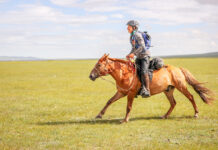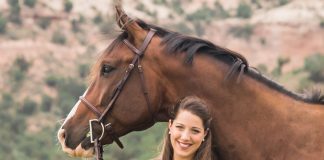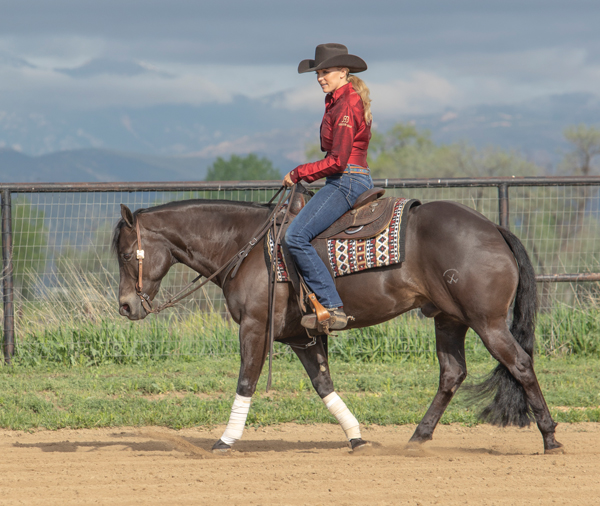
Good horsemanship means having control over your horse’s body and knowing that your horse will listen to your cues. To perform any high-level show maneuver, your horse needs to listen and respond as you move his shoulders and hips.
Here, trainer and coach Sharee Schwartzenberger shares the exercises she teaches all riders to do during daily warmups. The skills will help you feel confident, knowing that your horse is listening and willing to follow any directional cue. Learning how to move your horse’s body in any direction gives you the ultimate control. Plus, you’ll have a go-to list of exercises to gain your horse’s attention and focus.
Body Control
Make these exercises part of your warm-up routine. Get your horse outfitted in his usual tack and head to the arena. You may ride with one hand or two. However, you should be working up to one-handed riding.
Begin at a walk and then trot. Your goal is to have your horse move forward and sideways at the same time. In dressage, this move is called a leg-yield. The same movement is important for reining and western horses because it helps the horse move his shoulders and hips. Plus, your horse will have to listen to your aids as you warm up.
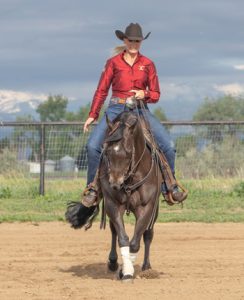
The Leg-Yield: First, get your horse moving. He’ll begin to warm up while listening to your cues to move to the left or right. This skill will help your horse move away from pressure and move his hips in the direction you want. When you work up to flying lead changes, you’ll need this control over your horse. You’ll also need this sideways movement for many ranch riding requirements.
Start at the far end of the arena so that you have plenty of room in front of you. Ask your horse to walk straight ahead, and then ask him to move to the left while he maintains his forward motion. Move your left leg away from your horse’s body and apply leg pressure with your right leg. Pick up your reining hand slightly to help your horse know that you want him to move to the side and not faster.
Make sure that your horse is crossing his front and back legs as he moves. He should maintain a straight body position and not bend or turn. When your horse is listening well, calmly moving to the side while staying straight in his body,
practice again at the trot.
If your horse leans in to you or refuses to move forward and sideways, try adding intermittent leg pressure. Kick your leg gently to reinforce the cue to move to the side without giving your horse constant pressure to push against. Once your horse takes even a small step to the side, remove the pressure and praise him for the smallest effort. He’ll learn when you release the pressure and offer praise.
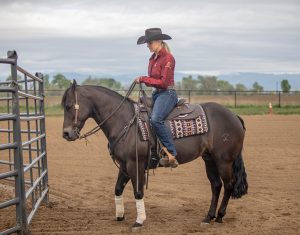
The Sidepass: If you’re still having trouble or simply need another exercise to practice, add a barrier. Work at a walk while asking your horse to face a fence or wall. With the barrier in front of you, you can focus on the sideways movement and help your horse understand that you don’t want him to move forward.
Begin by moving from right to left. Move your left leg away from your horse’s side and apply pressure with your right leg. Keep light pressure on the bridle by picking up your reining hand. This will help block his forward motion and keep the horse engaged. Make sure not to pull back.
You may need to move your right leg forward toward the horse’s shoulder then back behind the cinch to move the hips. Find the “sweet spot” where you can apply pressure while keeping his whole body moving to the side without turning. If he takes a step, release your cues and praise him.
Once your horse understands, only apply pressure in the spot where your leg naturally hangs—in the middle of his belly. This cue should help him know to move his shoulders and hips to the side. When your horse easily moves to the left, practice again while moving to the right.
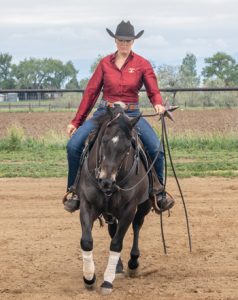
Circling and Redirecting
You should be able to keep your hand in the center of the saddle horn without having to constantly steer. Here, you’ll test your horse’s willingness to keep listening to your cue—even once your hand is back in the middle and he could choose to take his own path.
You’ll teach your horse to respond to your cues and then move forward on a loose rein. You’ll teach him to stay in the middle of the reins and build up to consistent neck reining.
Redirecting Exercise: To start, trot a large circle in the middle of the arena. Plan where your circle will go and place your reining hand in front of the saddle horn. If you feel your horse pulling to one side (or bending his neck away from your relaxed hand), pick up your reins and move your reining hand up and to the side to correct him. Ride a few strides with your hand in this position.
Ask your horse to move over by applying leg pressure; then put your hand back in the middle. If he is pulling to the right, steer him to the left, applying right leg pressure. If he pulls to the gate, redirect him away and make him stay in the circle.
Help him learn that if he steps out of the circle at all, there will be a correction.
You want to stay on the path of your circle without him pulling in
any direction.
Cut the Circle: Next, mix up straight lines and circling. Trot a quarter of your circle, then turn right, moving straight across the circle’s diameter. To turn, pick up your hand in the direction you want to go and apply pressure with the opposite leg. To turn right, move your hand up and to the right and apply left leg pressure. After you’ve moved straight ahead, turn to the right again to get back on your circle. Ride another quarter circle before turning and going straight again.
Remember to keep your hand down in front of the saddle horn after you have told your horse what to do. You are still testing him to make sure that he’s listening and continuing your directions after you give them as you try to achieve control over your horse.
If at any time your horse moves off the path you choose, correct him for a few strides, then replace your hand. If you consistently correct and redirect your horse, he’ll know that he must listen, and he’ll happily stay on the path you choose. Practice daily and make sure to release pressure as soon as your horse does what he’s asked to do. Soon you’ll have control over your horse and a horse that listens well to any cue.
Thanks to Sharee Schwartzenberger and Game Day Surprise, an 11-year-old AQHA gelding, for demonstrating these exercises.
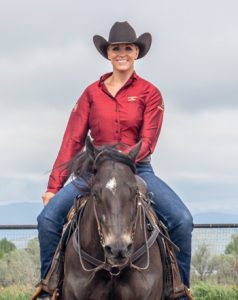
Meet the Trainer
Trainer and coach Sharee Schwartzenberger turned pro in 2017 after a lifetime of showing at top NRHA and AQHA events. Her freestyle reining performances have earned her top titles, and she’s won over $160,000 as an NRHA non-pro. She coaches youth riders and trains reining horses in Longmont, Colo.
This article about listening for better control over your horse originally appeared in the September 2019 issue of Horse Illustrated magazine. Click here to subscribe!



